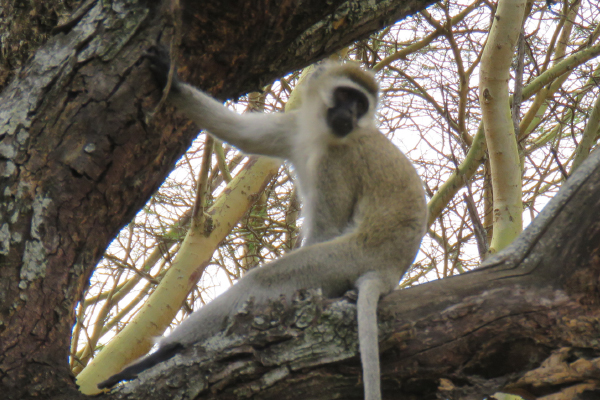Colobus Monkeys
Mount Kenya guereza (Colobus guereza kikuyuensis)
The Conservation status of Colobus guereza ssp. Kikuyuensis.
Synonyms
Angolan black and white Colobus, Eastern black and white Colobus Scientific name: Angolan black and white Colobus ( Colobus angolensis), Eastern black and white colobus (Colobus abyssinicus).
Habitat
Colobus live in all types of closed forests including Montane and Gallery forests. They may be found both in coastal forests and inland high-country areas. Bamboo stands are also common dwelling places of the Colobus.
Range
They are found in Eastern Africa in Kenya , Uganda, Tanzania, Rwanda, Burundi and Ethiopia, in Central Africa they are found in Congo DRC, Congo, in Western Africa in Benin,Cameroon, Gabon, Ghana, Guinea, Ivory Coast, Nigeria, Togo and Sierra Leone.
Physical Features
Colobus monkeys do not have thumbs. Their black fur contrasts with their long white mantle, beard and whiskers around the face, They also have a long white tail. The eastern black and white is distinguishable by U-shaped cape of white hair running from the shoulders to lower back., whereas the Angolan black and white has white hairs flaring out only on the shoulders.
Behavioral Characteristics
The black and white Colobus is the most aboreal of all African monkeys and rarely descends to the ground. They use their mantle hair and tail as parachutes during long leaps. Colobus monkeys live in troops of about 5-10 animals consisting of a dominant male, several females and their young. Colobus monkeys do not have a distinct breeding period although most mating occurs during the rainy season. They are strict leaf-eaters and prefer tender young leaves found in treetops. Their complex stomachs enable them to digest mature or toxic foliage that other monkeys cannot.
Interesting Facts
The name Colobus is a Greek derivative meaning ‘mutilated one ‘, this is due to the absence of thumbs. They communicate via song-like calls, a warning call and a mating call. Learn more.
Currently, we are in the process of rescuing a threatened population in the Kipipiri area. Learn more.
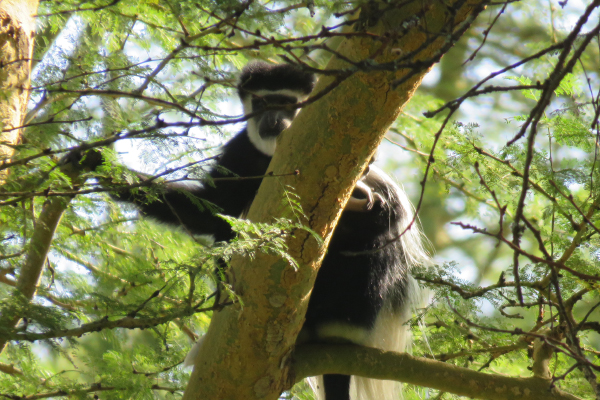
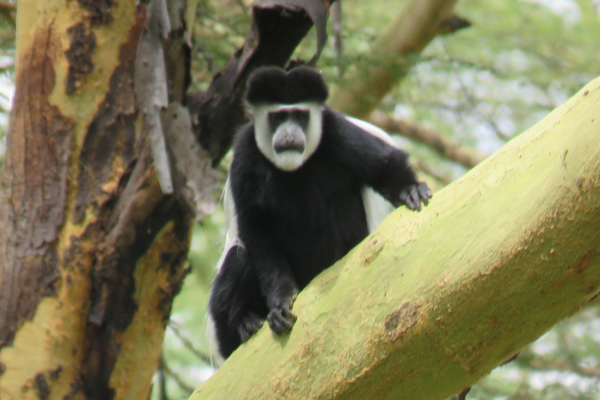
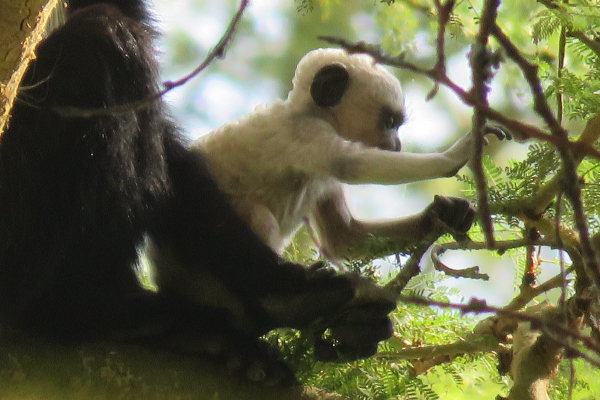
Sykes Monkey
The Conservation status of Cercopithecus mitis ssp. Kolbi.
Kolb’s Monkey
Cercopithecus mitis kolbi .Medium-sized (6 kg) arboreal primate. Found in the forests of the Kenya Highlands. Numbers decreasing due to habitat loss and degradation. Red List status ‘Least Concern’. Learn more.
“The graben floor in East Africa varies from 580 m asl at L. Magadi to 1,890 m asl near L. Naivasha. Cercopithecus m. manyaraensis and C. m. kolbi are the only two subspecies of C. mitis in East Africa found on the floor of the ERV. The only kolbi known to occur on the floor of the ERV are in riverine forest at L. Elementaita (1,670 m asl), southwest Kenya (Fig. 4). This population of <100 individuals (K. Combes and P. Mwangi pers. comm.) may still have a tenuous connection with the large population on the Aberdare Range and Mt. Kenya to the east, but remains c. 65 km from the nearest known group of stuhlmanni in the Mau Forest to the west. Note, however, that an apparently dispersing, solitary, adult male stuhlmanni was camera-trapped by C. Wilkinson (pers. comm.) in open habitat in south Lake Nakuru NP, c. 35 km from the nearest kolbi.”
(Biogeography of the Gentle Monkey Cercopithecus mitis Wolf, 1822 (Primates: Cercopithecidae) in Southwest Kenya and Northwest Tanzania, and Designation of a New Subspecies Endemic to Tanzania – Thomas M. Butynski, PhD and Yvonne A. de Jong, PhD)
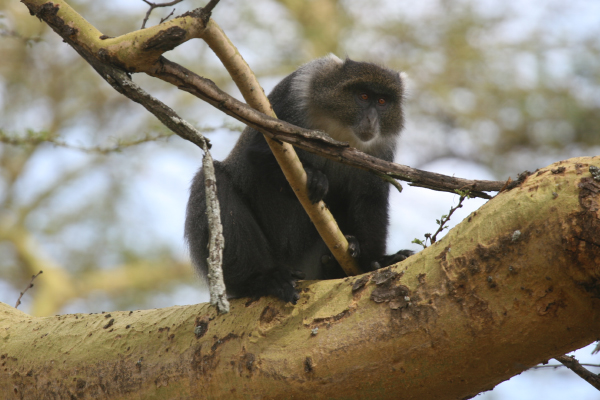
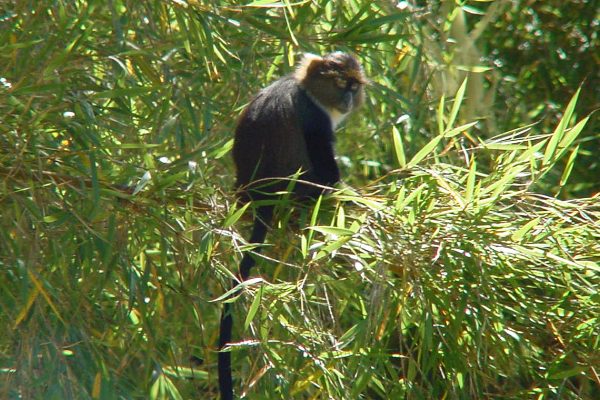
Olive Baboon
The Conservation status of Papio Anubis.
Baboons belong to the group of Old World monkeys. They are found in North-Central and Eastern Africa. They inhabit open grassland near wooded areas. They are also found in moist evergreen forests and near areas of human habitation. Five species of baboons have been described: P.hamadryas, P.papio, P.anubis, P.cyanocephalus and P.ursinus. They have a lifespan of 25 – 30 years in the wild, and can live for approximately 40 – 45 years in captivity.The main species housed at the Institute of Primate Research is P.anubis(Olive baboon). These have a greenish grey hair coat cover as adults while the infants have a black coat. Unlike other baboons, they have long pointed muzzles, close set eyes, powerful jaws, thick fur except on their muzzle, a short tail and rough spots on their protruding hind quarters. The males weigh approximately 24 kg while the females weigh approximately 14.7 kg. The adult males have long hair forming a mane from the top of their heads through their shoulders, gradually shortening down the back. Olive baboons are omnivores and consume a huge variety of feed including roots, tubers, corms, fruits, leaves, flowers, birds, birds’ eggs and vertebrates (including other primates). The use of non human primates such as baboons is especially critical given their structural and physiological homology with humans. Studies previously carried out in baboons have led to major breakthroughs in the development of curative and prophylactic products to enhance disease control. Baboons are thus used as experimental models for safety, feasibility and efficacy of these products. Baboons are therefore especially to the following disciplines in IPR, Reproductive health and biology, Neuroscience (Alzheimer’s disease), Infectious diseases (Schistosomiasis and malaria). Learn more.
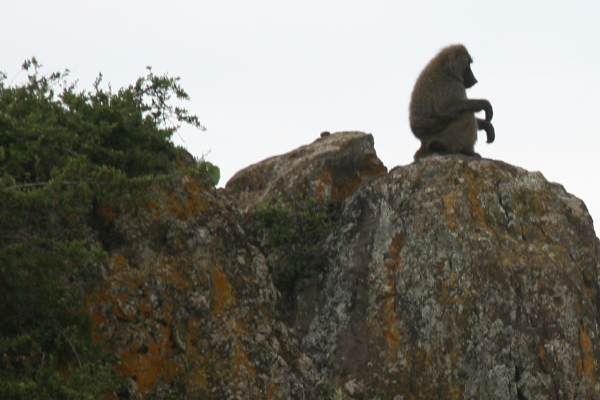
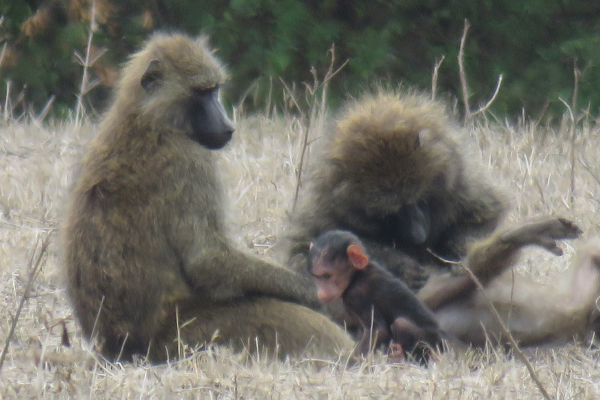
Vervet Monkey
The Conservation status of Chlorocebus pygerythru.
The vervet is a grey – brown monkey with a green back, white fringed black face, long whitish cheek whiskers, white fur surrounding the eyes, black feet, black tip to tail and blue scrotum.
Their weights range from 4 -7 kg and 2.5 – 3.5 kg for males and females respectively. Infants have pink faces and a lighter coloration than adults. It is said there are 21 subspecies, with Kenyan subspecies C.a.pygerythrus (Amboseli and Coastal region), C.a.arenarius (Samburu and Northern regions) and C.a.tantalus (Western region).
For simplicity all vervets are considered to be part of the C.aethiops species. The vervet is found in savannah, woodland, riverine, gallery, lakeshore, and coastal forests. They compete with baboons as the most widely distributed of all the African monkeys and the most abundant monkey in the world. Like the baboons, Vervets are opportunistic eaters, which allow them to survive on a wide variety of conditions by eating various food types.
They are truly omnivorous, eating fruits, buds, seeds, roots, bark, flowers, gum, insects, small vertebrates and eggs. They will travel for 1-2km daily. Vervets are found in multi-male multi-female groups with linear dominance hierarchy among males and matriarchal kin group relationship among the females. Sexual consortships are not formed and there is no paternal care of offspring after birth. Learn more.
